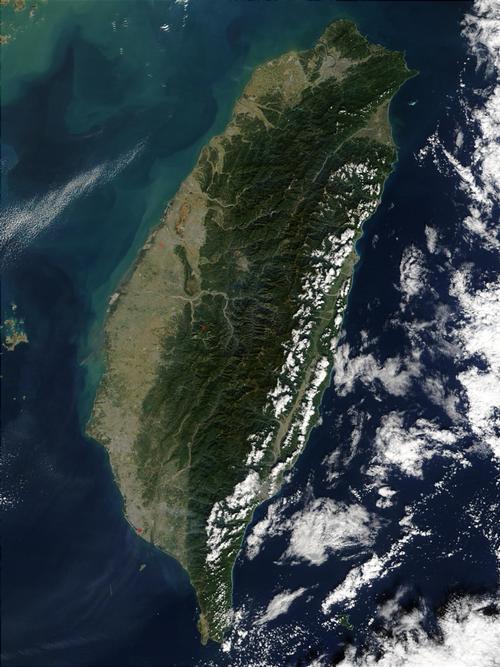TAIWAN


Geography and Landscape
Geography
The island of Taiwan is located 160 kilometres southeast of China, between the Taiwan Strait and the Philippine Sea. The area of Taiwan is 36,197 square kilometres.

Landscape
On the west coast is a narrow strip of fertile land, where ninety per cent of the entire population lives. The east of Taiwan consists mainly of jagged, rocky coastal territory. Between the two coasts lies a mountain range. Mount Yu-Shan, at 3952 metres, is the second highest point in north-east Asia after Tibet.
 Yu-Shan, highest mountain in TaiwanPhoto: Grantabc99 CC 4.0 Internationalno changes made
Yu-Shan, highest mountain in TaiwanPhoto: Grantabc99 CC 4.0 Internationalno changes made
The small islands belonging to Taiwan are called Penghu, Lanyu, Green, Kinmen, Matsu and Wuchiu.
Climate and Weather
Taiwan has a (sub)tropical climate with high rainfall and is prone to typhoons. Summers are hot and sticky, with much precipitation in the mountains. The temperature then averages around thirty degrees. During the winter, it rains almost constantly in the north. It also snows regularly. In the south-west, the winters are milder with an average temperature of about twenty degrees.
Plants and Animals
Plants
The most common trees are the acacia, beech, cypress, fir, oak, camphor, laurel and elm.
The national flower of Taiwan is the blossom of the Chinese plum tree.
Animals
Taiwan's forested mountain slopes still protect the island's dwindling wildlife population. Despite its shrinking habitat, Taiwan still has 70 species of mammals, 90 species of reptiles, 500 species of birds and 18,000 species of insects. Its lakes, streams and coastal waters contain 2,700 species of fish.
Many of Taiwan's mammals are unique to the island, having evolved autonomously from mainland Asia. The largest of the mammals is the Taiwanese black bear, a subspecies of the Asiatic black bear. The Taiwanese black bear lives at altitudes above 2,000 m, weighs up to 200 kg and has long, curved nails that enable it to dig for roots and insects. The Taiwanese black bear is severely threatened by habitat loss and illegal hunting.
Another well-known mammal of the island is the Taiwanese rock macaque or Formosa rock macaque. This macaque species has a reddish face and its fur changes with the seasons. The animal measures around 100 cm including its tail and weighs up to 8 kg. Taiwanese macaques live mainly on the forested mountain slopes of national parks, but never higher than 3000 metres.
The unusual-looking Chinese pangolin is a cross between an armadillo and an anteater. This shy, slow-moving insect eater is nocturnal and uses its long, sticky tongue to devour insects. When in danger, it can roll itself up in its entirety or use its scaly tail to viciously lash out and spray a foul-smelling liquid on its attackers.
In 2013, it was announced that the Taiwanese subspecies of clouded leopard is officially considered extinct. Thirteen years of intensive searching for the magnificent predator have resulted in no specimens being found. Large mammals that can still be found on Taiwan are the Taiwanese wild boar and the Taiwanese or Formosasambar (also called horse deer or Aristotle deer).
Taiwan 's coastal marshes and sheltered bays make the island an attractive resting place for migratory birds. So far, 500 bird species have been spotted in Taiwan. Not surprisingly, birdwatching has become a popular hobby, and bird sanctuaries have been established in many parts of Taiwan. Until recently, economic prosperity was more important to most Taiwanese than bird protection. But because of nature organisations, bird protection in Taiwan slowly started to gain momentum in the 1980s, and the island now has more than fifty important bird areas, which together cover almost 20% of Taiwan's surface.
Taiwan is home to two very small owl species, a subspecies of the spotted dwarf owl and a subspecies of the collared dwarf owl. The Taiwanese Blue Magpie is a large bird (64 cm) with white feathers in its tail. Among the rare species that visit Taiwan is the little spoonbill, of which it is estimated that there are only a few hundred left in the world. Many of them spend the winter near the Zengwen River. A favourite among birdwatchers is the Chinese pitta, which builds its nest in Taiwan in summer and has a very colourful plumage.
Taiwan is also home to a number of bird species found nowhere else in the world, including:
- Taiwan bluetail
- Taiwang goldcrest
- Formosa kitta
- Formosa whistling thrush
- Mikado pheasant
- Steere's timalia
- Formosa bulbul
- Swinhoe's pheasant
- Taiwan bush singer
- Taiwan forest partridge
The national fish of Taiwan is the masu salmon.
Sources
Elmar Landeninformatie
CIA - World Factbook
BBC - Country Profiles
Copyright: Team The World of Info